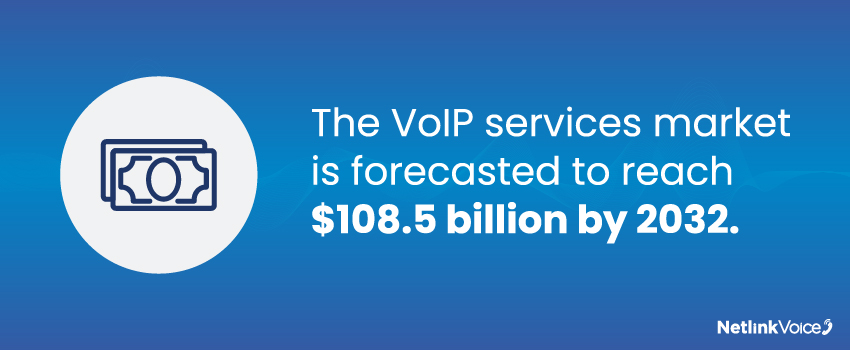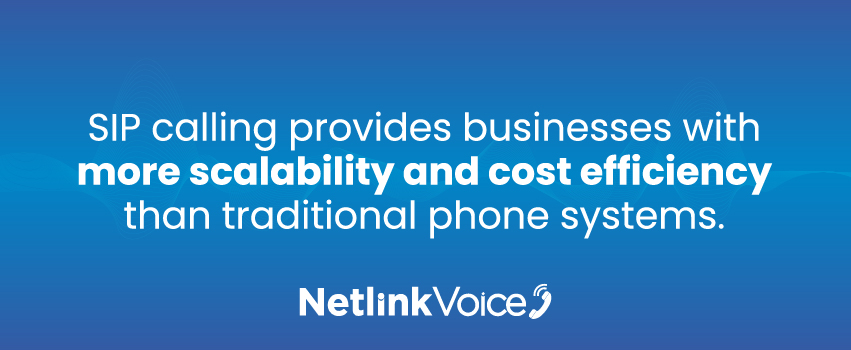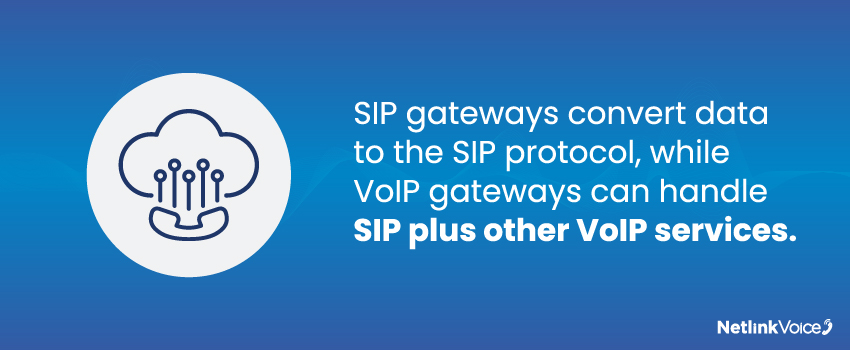Voice over Internet Protocol (VoIP) technology has transformed business communications, enabling companies to leverage internet connectivity for voice calls, video conferencing, and multimedia sharing. The VoIP services market is forecasted to reach $108.5 billion by 2032,1 driven by low setup and maintenance costs and the need for increased flexibility as more organizations move operations to the cloud.
At the heart of this transformation lies the Session Initiation Protocol (SIP), an application-layer protocol that facilitates the setup, management, and teardown of communication sessions over IP telephony networks. One critical component that enables the integration of traditional telephony systems with modern VoIP approaches is the SIP gateway. We explain how SIP gateways work and share best practices for a seamless and efficient communication experience below.
Basics Of SIP Technology
Before diving into SIP gateways, let’s first discuss the basics of SIP technology.
SIP Trunking
SIP trunking delivers voice communication and other communication channels over an internet connection. It uses the SIP protocol to connect an organization’s PBX (Private Branch Exchange) to the internet, which enables it to communicate with the Public Switched Telephone Network (PSTN).
This connection is facilitated by a SIP trunk, which acts as a virtual version of an analog telephone line. The SIP trunk handles the signaling and control necessary for voice, video, and instant messaging applications.
By leveraging the internet, SIP calling provides businesses with more scalability and cost efficiency. If you need to adjust the number of SIP channels from one month to the next, you can simply log in and make the necessary changes – a level of flexibility not available with landlines.
SIP ALG
An Application Layer Gateway (ALG) for SIP (Session Initiation Protocol) is a software component built into network devices like routers, firewalls, or NAT (Network Address Translation) devices. It is designed to facilitate the traversal of SIP traffic across networks, especially when NAT or firewalls are involved.
SIP is commonly used in Voice over IP (VoIP) communications to establish and manage voice and video calls, messaging, and other real-time communication sessions. However, SIP traffic often encounters issues when passing through NATs and firewalls due to the way these devices handle IP addresses and ports. ALG helps address these issues.

What Is A SIP Gateway?
A SIP gateway bridges the gap between traditional telephony systems and modern Voice over Internet Protocol (VoIP) approaches. Businesses still using traditional Primary Rate Interface (PRI) lines can use a SIP gateway to connect PRI circuits to a VoIP system and take advantage of SIP trunking. These gateways connect legacy phone systems (such as PBXs or ACDs) with SIP resources or integrate a modern VoIP phone system with legacy phone lines.
The SIP gateway connects to the legacy system through either analog or digital trunk ports. From the PBX’s perspective, the gateway appears as either a phone line or a networked PBX. Phone calls from the PBX to the outside world are converted into SIP calls and transmitted over an internet connection to a SIP provider or other VoIP peers. Incoming voice calls from VoIP devices are converted into the correct legacy protocol and delivered to the PBX.
SIP Gateway vs SIP Trunking
Function
A SIP Gateway connects traditional telephony systems (like analog phones or legacy PBXs) to VoIP networks, while SIP Trunking provides virtual phone lines over the internet for VoIP communication.
Hardware vs Service
A SIP Gateway is a physical device or software solution, whereas SIP Trunking is a subscription-based service offered by VoIP providers.
Use Case
SIP Gateways are essential for businesses transitioning from legacy systems to VoIP, while SIP Trunking is used to enable VoIP communication directly without the need for traditional phone lines.
How A SIP Gateway Works
Incorporating SIP into a traditional phone system is an effective way to introduce new features and reduce costs. Here’s how a SIP gateway makes this possible:
Signal Conversion
The primary function of a SIP gateway is to convert voice signals from one format to another. When a call is initiated from a traditional phone, the voice signal is in an analog format. The SIP gateway converts this analog signal into a digital format to send over an IP network. This process, known as signal conversion, is essential for enabling communication between different types of networks.
Protocol Translation
Traditional phone systems use different signaling protocols than IP networks. The SIP gateway translates these protocols, ensuring that the call can be understood and processed by both the legacy phone system and the IP telephony network. This translation is crucial for maintaining compatibility and enabling seamless communication.
Call Routing
Once the voice signal is converted and the protocols are translated, the SIP gateway routes the call to its destination. The gateway uses SIP to establish and manage the call session, ensuring that the call is connected to the correct endpoint. This routing process involves determining the best path for the call based on telephone network conditions and available bandwidth.
Media Handling
SIP gateways also handle media streams, which include the actual voice or video data being transmitted during the call. The gateway ensures that these media streams are properly encoded and decoded, allowing for clear and high-quality communication. Additionally, the SIP gateway manages any necessary media transcoding, which is the process of converting media from one codec to another to ensure compatibility between different systems.
The Benefits Of SIP Gateways
Now that we know how a SIP gateway works, let’s explore the benefits it offers for businesses:
Better Call Quality
A primary advantage of SIP trunking is the exceptional call quality it offers. Many businesses hesitate to switch from traditional phones due to concerns about poor call quality. However, SIP phones can provide crisp, clear voice calls by allocating sufficient bandwidth to efficiently handle all concurrent calls.
Increased Mobility
Another significant benefit of SIP trunking is its support for global mobility. While traditional phone lines limit how quickly and how far you can expand your business, SIP trunks use your internet connection, allowing you to scale your operations as far and wide as your business demands. Your teams can access communications channels from any device connected to the internet, including a laptop or mobile phone.

More Scalability
SIP trunking is highly scalable, making it an ideal solution for growing businesses. If you need to increase or decrease the number of SIP channels from one month to the next, you can easily do so by logging into your account and making the necessary adjustments – a level of flexibility not available with a traditional phone network.
Easy Management
SIP gateways are known for their ease of use and management. IT teams no longer have to endure long wait times for support, as SIP comes with simple administrative portals that allow administrators to manage virtually all aspects of the trunking system on-site.
Cost Savings
Many businesses that utilize a SIP trunk report a rapid return on investment (ROI). Since there are no significant upfront costs associated with investing in SIP phones, companies can immediately benefit from lower bills and more reliable service.
SIP Gateway Best Practices
SIP gateways are highly safe and secure, but you still need to take proactive measures to ensure your company’s phone system is as secure as possible. Here are some tips to help you achieve this:
Protect SIP Calls
While a SIP gateway offers a certain level of protection, it is not foolproof. One way to enhance the security of SIP calls is to create an encrypted call by adding “SIPS” instead of “SIP” at the start of the call, which ensures the connection is encrypted and, therefore, much safer.
Additionally, administrators can encrypt the content being sent and received via the SIP connection. This added protection ensures that even if someone manages to breach the connection, they will likely be unable to understand the messages being transmitted. A simple way to achieve this is by running the call through a Virtual Private Network (VPN) connection. However, it’s essential to test the VPN before using it for telephone calls, as it could negatively impact voice call quality.
Implement Cybersecurity Measures
Many businesses overlook the fact that malware can be introduced into the SIP phone system via instant messages, similar to how it happens on PCs and mobile devices.
It is possible to launch malware attacks that target phone lines specifically, potentially gathering and transmitting vital information to unauthorized parties, interfering with the functionality of the phone lines, or completely disabling them. These attacks can also infiltrate the rest of the business network.
To prevent such attacks, you’ll need to configure your endpoint devices to require SIP authentication. Your system should be set up to require:
-
- Authenticated usernames
-
- Valid Uniform Resource Identifiers (URIs)
-
- Secure passwords
Companies should also ensure that their prevention and intrusion protection systems are adapted to their IP networks and require strong passwords for all SIP devices.
Set Up A Virtual LAN
When dealing with phone calls from within the organization, you can set up a virtual LAN for your VoIP, remote office, or VPN. These can provide a separate telephone network for voice traffic, helping boost security. The best approach is to use a SIP-capable firewall capable of blocking non-SIP traffic, examining the contents of messages for malware, and guarding against various spoofing methods.

SIP Gateways vs VoIP Gateways
While SIP gateways and VoIP gateways both send voice data over an internet protocol, they are not exactly the same. VoIP is an overarching category that includes various voice solutions, one of which is SIP.
A SIP gateway converts data into a specific SIP signal, while a VoIP gateway can convert SIP as well as other VoIP services, depending on the PBX’s capabilities. In some configurations, SIP gateways can be combined with VoIP gateways to optimize data traffic, especially when running multiple types of unified communications data, such as voice and video calls.
SIP Gateway vs PBX
Function
A SIP Gateway connects legacy telephony systems to VoIP networks by converting analog or digital signals into SIP-based IP packets. A PBX (Private Branch Exchange) manages internal and external call routing within an organization.
Role
SIP Gateways act as a bridge for legacy systems, while PBXs provide call management features like voicemail, call forwarding, and conferencing.
Hardware vs Purpose
A SIP Gateway is a standalone hardware or software solution focused on connectivity, while a PBX can be hardware-based, software-based, or cloud-hosted, handling overall telephony for an organization.
Transform Your Business With SIP Calling From Netlink Voice
A SIP gateway is an essential tool for businesses looking to bridge the gap between legacy telephony systems and modern VoIP approaches. By enabling the seamless integration of traditional setups with SIP-based communication networks, these gateways unlock a range of advantages, including cost savings, scalability, and enhanced mobility.
If you’re looking to modernize your business communications, Netlink Voice can help. Our simple, powerful cloud communications solution, ConnectWare, harnesses SIP technology to deliver voice, text, chat, video, presence management, real-time wallboards, and reporting – all from a single, integrated IP PBX system.
Ready to get started with a hassle-free phone system? Reach out to Netlink Voice today!
Sources:

